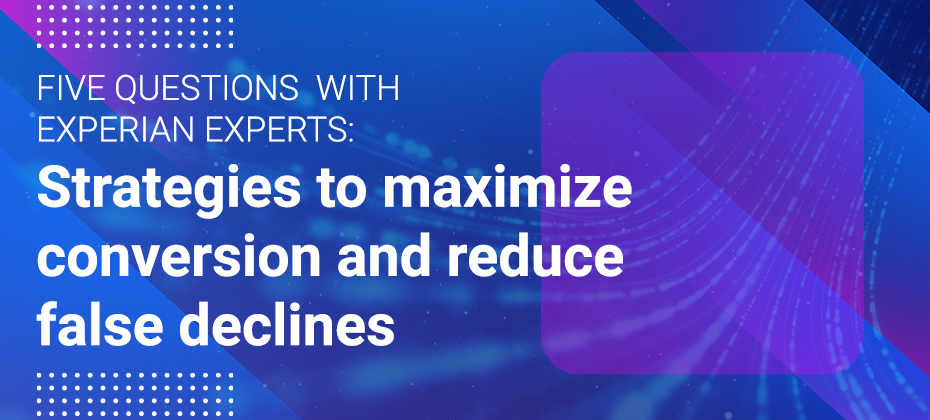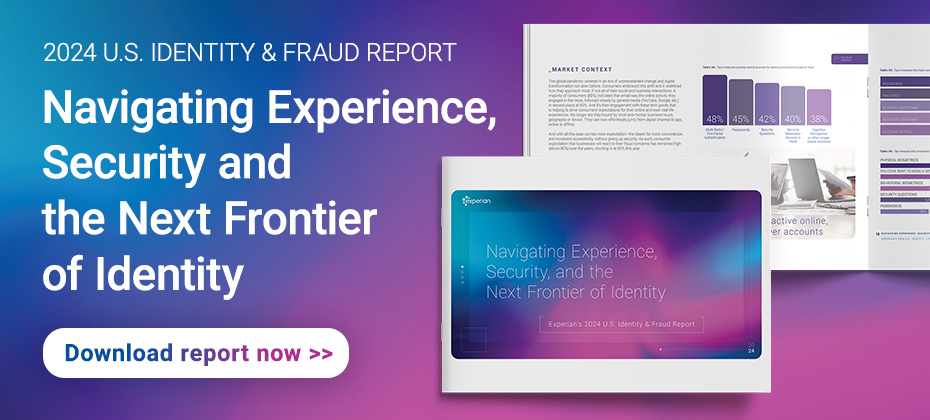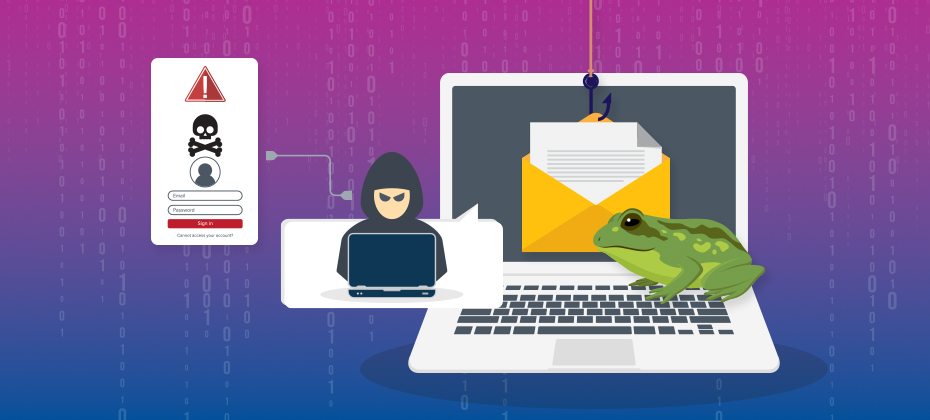Tag: fraud

There’s a common saying in the fraud prevention industry: where there’s opportunity, fraudsters are quick to follow. Recent advances in technology are providing ample new opportunities for cybercriminals to exploit. One of the most prevalent techniques being observed today is password spraying. From email to financial and health records, consumers and businesses are being impacted by this pervasive form of fraud. Password spraying attacks often fly under the radar of traditional security measures, presenting a unique and growing threat to businesses and individuals. What is password spraying? Also known as credential guessing, password spraying involves an attacker applying a list of commonly used passwords against a list of accounts in order to guess the correct password. When password spraying first emerged, an individual might hand key passwords to try to gain access to a user’s account or a business’s management system. Credential stuffing is a similar type of fraud attack in which an attacker gains access to a victim’s credentials in one system (e.g., their email, etc.) and then attempts to apply those known credentials via a script/bot to a large number of sites in order to gain access to other sites where the victim might be using the same credentials. Both are brute-force attack vectors that eventually result in account takeover (ATO), compromising sensitive data that is subsequently used to scam, blackmail, or defraud the victim. As password spraying and other types of fraud evolved, fraud rings would leverage “click farms” or “fraud farms” where hundreds of workers would leverage mobile devices or laptops to try different passwords in order to perpetrate fraud attacks on a larger scale. As technology has advanced, bot attacks fueled by generative AI (Gen AI) have taken the place of humans in the fraud ring. Now, instead of hand-keying passwords into systems, workers at fraud farms are able to deploy hundreds or thousands of bots that can work exponentially faster. The rise and evolution of bots Bots are not necessarily new to the digital experience — think of the chatbot on a company’s support page that helps you find an answer more quickly. These automated software applications carry out repetitive instructions mimicking human behavior. While they can be helpful, they can also be leveraged by fraudsters, to automate fraud on a brute-force attack, often going undetected resulting in substantial losses. Generation 4 bots are the latest evolution of these malicious programs, and they’re notoriously hard to detect. Because of their slow, methodical, and deliberate human-like behavior, they easily bypass network-level controls such as firewalls and popular network-layer security. Stopping Gen4 bots For any company with a digital presence or that leverages digital networks as part of doing business, the threat from Gen AI enabled fraud is paramount. The traditional stack for fighting fraud including firewalls, CAPTCHA and block lists are not enough in the face of Gen4 bots. Companies at the forefront of fighting fraud are leveraging behavioral analytics to identify and mitigate Gen AI-powered fraud. And many have turned to industry leader, Neuro ID, which is now part of Experian. Watch our on-demand webinar: The fraud bot future-shock: How to spot & stop next-gen attacks Behavioral analytics is a key component of passive and continuous authentication and has become table stakes in the fraud prevention space. By measuring how a user interacts with a form field (e.g., a website, mobile app, etc.) our behavioral analytics solutions can determine if the user is: a potential fraudster, a bot, or a genuine user familiar with the PII entered. Because it’s available at any digital engagement, behavioral data is often the most consistent signal available throughout the customer lifecycle and across geographies. It allows risky users to be rejected or put through more rigorous authentication, while trustworthy users get a better experience, protecting businesses and consumers from Gen AI-enabled fraud. As cyber threats evolve, so must our defenses. Password spraying exemplifies the sophisticated methods and technologies attackers now employ to scale their fraud efforts and gain access to sensitive information. To fight next-generation fraud, organizations must employ next-generation technologies and techniques to better defend themselves against this and other types of cyberattacks. Experian’s approach embodies a paradigm shift where fraud detection increases efficiency and accuracy without sacrificing customer experience. We can help protect your company from bot attacks, fraudulent accounts and other malicious attempts to access your sensitive data. Learn more about behavioral analytics and our other fraud prevention solutions. Learn more

A tale of synthetic ID fraud Synthetic ID fraud is an increasing issue and affects everyone, including high-profile individuals. A notable case from Ohio involved Warren Hayes, who managed to get an official ID card in the name of “Santa Claus” from the Ohio Bureau of Motor Vehicles. He also registered a vehicle, opened a bank account, and secured an AAA membership under this name, listing his address as 1 Noel Drive, North Pole, USA. This elaborate ruse unraveled after Hayes, disguised as Santa, got into a minor car accident. When the police requested identification, Hayes presented his Santa Claus ID. He was subsequently charged under an Ohio law prohibiting the use of fictitious names. However, the court—presided over by Judge Thomas Gysegem—dismissed the charge, arguing that because Hayes had used the ID for over 20 years, "Santa Claus" was effectively a "real person" in the eyes of the law. The judge’s ruling raised eyebrows and left one glaring question unanswered: how could official documents in such a blatantly fictitious name go undetected for two decades? From Santa Claus to synthetic IDs: the modern-day threat The Hayes case might sound like a holiday comedy, but it highlights a significant issue that organizations face today: synthetic identity fraud. Unlike traditional identity theft, synthetic ID fraud does not rely on stealing an existing identity. Instead, fraudsters combine real and fictitious details to create a new “person.” Think of it as an elaborate game of make-believe, where the stakes are millions of dollars. These synthetic identities can remain under the radar for years, building credit profiles, obtaining loans, and committing large-scale fraud before detection. Just as Hayes tricked the Bureau of Motor Vehicles, fraudsters exploit weak verification processes to pass as legitimate individuals. According to KPMG, synthetic identity fraud bears a staggering $6 billion cost to banks.To perpetrate the crime, malicious actors leverage a combination of real and fake information to fabricate a synthetic identity, also known as a “Frankenstein ID.” The financial industry classifies various types of synthetic identity fraud. Manipulated Synthetics – A real person’s data is modified to create variations of that identity. Frankenstein Synthetics – The data represents a combination of multiple real people. Manufactured Synthetics – The identity is completely synthetic. How organizations can combat synthetic ID fraud A multifaceted approach to detecting synthetic identities that integrates advanced technologies can form the foundation of a sound fraud prevention strategy: Advanced identity verification tools: Use AI-powered tools that cross-check identity attributes across multiple data points to flag inconsistencies. Behavioral analytics: Monitor user behaviors to detect anomalies that may indicate synthetic identities. For instance, a newly created account applying for a large loan with perfect credit is a red flag. Digital identity verification: Implement digital onboarding processes that include online identity verification with real-time document verification. Users can upload government-issued IDs and take selfies to confirm their identity. Collaboration and data sharing: Organizations can share insights about suspected synthetic identities to prevent fraudsters from exploiting gaps between industries. Ongoing employee training: Ensure frontline staff can identify suspicious applications and escalate potential fraud cases. Regulatory support: Governments and regulators can help by standardizing ID issuance processes and requiring more stringent checks. Closing thoughts The tale of Santa Claus’ stolen identity may be entertaining, but it underscores the need for vigilance against synthetic ID fraud. As we move into an increasingly digital age, organizations must stay ahead of fraudsters by leveraging technology, training, and collaboration. Because while the idea of Spiderman or Catwoman walking into your branch may seem amusing, the financial and reputational cost of synthetic ID fraud is no laughing matter. Learn more

We are squarely in the holiday shopping season. From the flurry of promotional emails to the endless shopping lists, there are many to-dos and even more opportunities for financial institutions at this time of year. The holiday shopping season is not just a peak period for consumer spending; it’s also a critical time for financial institutions to strategize, innovate, and drive value. According to the National Retail Federation, U.S. holiday retail sales are projected to approach $1 trillion in 2024, , and with an ever-evolving consumer behavior landscape, financial institutions need actionable strategies to stand out, secure loyalty, and drive growth during this period of heightened spending. Download our playbook: "How to prepare for the Holiday Shopping Season" Here’s how financial institutions can capitalize on the holiday shopping season, including key insights, actionable strategies, and data-backed trends. 1. Understand the holiday shopping landscape Key stats to consider: U.S. consumers spent $210 billion online during the 2022 holiday season, according to Adobe Analytics, marking a 3.5% increase from 2021. Experian data reveals that 31% of all holiday purchases in 2022 occurred in October, highlighting the extended shopping season. Cyber Week accounted for just 8% of total holiday spending, according to Experian’s Holiday Spending Trends and Insights Report, emphasizing the importance of a broad, season-long strategy. What this means for financial institutions: Timing is crucial. Your campaigns are already underway if you get an early start, and it’s critical to sustain them through December. Focus beyond Cyber Week. Develop long-term engagement strategies to capture spending throughout the season. 2. Leverage Gen Z’s growing spending power With an estimated $360 billion in disposable income, according to Bloomberg, Gen Z is a powerful force in the holiday market. This generation values personalized, seamless experiences and is highly active online. Strategies to capture Gen Z: Offer digital-first solutions that enhance the holiday shopping journey, such as interactive portals or AI-powered customer support. Provide loyalty incentives tailored to this demographic, like cash-back rewards or exclusive access to services. Learn more about Gen Z in our State of Gen Z Report. To learn more about all generations' projected consumer spending, read new insights from Experian here, including 45% of Gen X and 52% of Boomers expect their spending to remain consistent with last year. 3. Optimize pre-holiday strategies Portfolio Review: Assess consumer behavior trends and adjust risk models to align with changing economic conditions. Identify opportunities to engage dormant accounts or offer tailored credit lines to existing customers. Actionable tactics: Expand offerings. Position your products and services with promotional campaigns targeting high-value segments. Personalize experiences. Use advanced analytics to segment clients and craft offers that resonate with their holiday needs or anticipate their possible post-holiday needs. 4. Ensure top-of-mind awareness During the holiday shopping season, competition to be the “top of wallet” is fierce. Experian’s data shows that 58% of high spenders shop evenly across the season, while 31% of average spenders do most of their shopping in December. Strategies for success: Early engagement: Launch educational campaigns to empower credit education and identity protection during this period of increased transactions. Loyalty programs: Offer incentives, such as discounts or rewards, that encourage repeat engagement during the season. Omnichannel presence: Utilize digital, email, and event marketing to maintain visibility across platforms. 5. Combat fraud with multi-layered strategies The holiday shopping season sees an increase in fraud, with card testing being the number one attack vector in the U.S. according to Experian’s 2024 Identity and Fraud Study. Fraudulent activity such as identity theft and synthetic IDs can also escalate. Fight tomorrow’s fraud today: Identity verification: Use advanced fraud detection tools, like Experian’s Ascend Fraud Sandbox, to validate accounts in real-time. Monitor dormant accounts: Watch these accounts with caution and assess for potential fraud risk. Strengthen cybersecurity: Implement multi-layered strategies, including behavioral analytics and artificial intelligence (AI), to reduce vulnerabilities. 6. Post-holiday follow-up: retain and manage risk Once the holiday rush is over, the focus shifts to managing potential payment stress and fostering long-term relationships. Post-holiday strategies: Debt monitoring: Keep an eye on debt-to-income and debt-to-limit ratios to identify clients at risk of defaulting. Customer support: Offer tailored assistance programs for clients showing signs of financial stress, preserving goodwill and loyalty. Fraud checks: Watch for first-party fraud and unusual return patterns, which can spike in January. 7. Anticipate consumer trends in the New Year The aftermath of the holidays often reveals deeper insights into consumer health: Rising credit balances: January often sees an uptick in outstanding balances, highlighting the need for proactive credit management. Shifts in spending behavior: According to McKinsey, consumers are increasingly cautious post-holiday, favoring savings and value-based spending. What this means for financial institutions: Align with clients’ needs for financial flexibility. The holiday shopping season is a time that demands precise planning and execution. Financial institutions can maximize their impact during this critical period by starting early, leveraging advanced analytics, and maintaining a strong focus on fraud prevention. And remember, success in the holiday season extends beyond December. Building strong relationships and managing risk ensures a smooth transition into the new year, setting the stage for continued growth. Ready to optimize your strategy? Contact us for tailored recommendations during the holiday season and beyond. Download the Holiday Shopping Season Playbook

As online accounts become essential for activities ranging from shopping and social media to banking, "account farming" has emerged as a significant fraud risk. This practice involves creating fake or unauthorized accounts en masse, often for malicious purposes. Understanding how account farming works, why it’s done and how businesses can protect themselves is crucial for maintaining data integrity, safeguarding customer trust and protecting your bottom line. How does account farming work? Account farming is the process of creating and cultivating multiple user accounts, often using fake or stolen identities. These accounts may look like legitimate users, but they’re controlled by a single entity or organization, usually with fraudulent intent. Here’s a breakdown of the typical steps involved in account farming: Identity generation: Account farmers start by obtaining either fake or stolen personal information. They may buy these datasets on the dark web or scrape publicly available information to make each account seem legitimate. Account creation: Using bots or manual processes, fraudsters create numerous accounts on a platform. Often, they’ll employ automated tools to expedite this process, bypassing CAPTCHA or reCAPTCHA systems or using proxy servers to mask their IP addresses and avoid detection. Warm-up phase: After initial creation, account farmers often let the accounts sit for a while, engaging in limited, non-suspicious activity to avoid triggering security alerts. This “warming up” process helps the accounts seem more authentic. Activation for fraudulent activity: Once these accounts reach a level of credibility, they’re activated for the intended purpose. This might include spamming, fraud, phishing, fake reviews or promotional manipulation. Why is account farming done? There are several reasons account farming has become a widespread problem across different industries. Here are some common motivations: Monetary gain: Fraudsters use farmed accounts to commit fraudulent transactions, like applying for loans and credit products, accessing promotional incentives or exploiting referral programs. Spam and phishing: Fake accounts enable widespread spam campaigns or phishing attacks, compromising customer data and damaging brand reputation. Data theft: By creating and controlling multiple accounts, fraudsters may access sensitive data, leading to further exploitation or resale on the dark web. Manipulating metrics and market perception: Some industries use account farming to boost visibility and credibility falsely. For example, on social media, fake accounts can be used to inflate follower counts or engagement metrics. In e-commerce, fraudsters may create fake accounts to leave fake reviews or upvote products, falsely boosting perceived popularity and manipulating purchasing decisions. How does account farming lead to fraud risks? Account farming is a serious problem that can expose businesses and their customers to a variety of risks: Financial loss: Fake accounts created to exploit promotional offers or referral programs can cause victims to experience significant financial losses. Additionally, businesses can incur costs from chargebacks or fraudulent refunds triggered by these accounts. Compromised customer experience: Legitimate customers may suffer from poor experiences, such as spam messages, unsolicited emails or fraudulent interactions. This leads to diminished brand trust, which is costly to regain. Data breaches and compliance risks: Account farming often relies on stolen data, increasing the risk of data breaches. Businesses subject to regulations like GDPR or CCPA may face hefty fines if they fail to protect consumer information adequately. READ MORE: Our Data Breach Industry Forecast predicts what’s in store for the coming year. How can businesses protect themselves from account farming fraud? As account farming tactics evolve, businesses need a proactive and sophisticated approach to detect and prevent these fraudulent activities. Experian’s fraud risk management solutions provide multilayered and customizable solutions to help companies safeguard themselves against account farming and other types of fraud. Here’s how we can help: Identity verification solutions: Experian’s fraud risk and identity verification platform integrates multiple verification methods to confirm the authenticity of user identities. Through real-time data validation, businesses can verify the legitimacy of user information provided at the account creation stage, detecting and blocking fake identities early in the process. Its flexible architecture allows companies to adapt their identity verification process as new fraud patterns emerge, helping them stay one step ahead of account farmers. Behavioral analytics: One effective way to identify account farming is to analyze user behavior for patterns consistent with automated or scripted actions (AKA “bots”). Experian’s behavioral analytics solutions, powered by NeuroID, use advanced machine learning algorithms to identify unusual behavioral trends among accounts. By monitoring how users interact with a platform, we can detect patterns common in farmed accounts, like uniform interactions or repetitive actions that don’t align with human behavior. Device intelligence: To prevent account farming fraud, it’s essential to go beyond user data and examine the devices used to create and access accounts. Experian’s solutions combine device intelligence with identity verification to flag suspicious devices associated with multiple accounts. For example, account farmers often use virtual machines, proxies or emulators to create accounts without revealing their actual location or device details. By identifying and flagging these high-risk devices, we help prevent fraudulent accounts from slipping through the cracks. Velocity checks: Velocity checks are another way to block fraudulent account creation. By monitoring the frequency and speed at which new accounts are created from specific IP addresses or devices, Experian’s fraud prevention solutions can identify spikes indicative of account farming. These velocity checks work in real-time, enabling businesses to act immediately to block suspicious activity and minimize the risk of fake account creation. Continuous monitoring and risk scoring: Even after initial account creation, continuous monitoring of user activity helps to identify accounts that may have initially bypassed detection but later engage in suspicious behavior. Experian’s risk scoring system assigns a fraud risk score to each account based on its behavior over time, alerting businesses to potential threats before they escalate. Final thoughts: Staying ahead of account farming fraud Preventing account farming is about more than just blocking bots — it’s about safeguarding your business and its customers against fraud risk. By understanding the mechanics of account farming and using a multi-layered approach to fraud detection and identity verification, businesses can protect themselves effectively. Ready to take a proactive stance against account farming and other evolving fraud tactics? Explore our comprehensive solutions today. Learn More This article includes content created by an AI language model and is intended to provide general information.

The risk of identity theft continues to grow yearly for consumers and businesses alike. Identity theft and fraud cases have nearly tripled over the past ten years, with cybercrime losses totaling more than $10 billion this year alone.[1] An effective way for organizations to combat these threats is to implement a policy of identity risk management. Identity risk management Identity risk management refers to the methods used by organizations to anticipate potential fraud threats, protect themselves and their consumers from those vulnerabilities, resolve any fraud incidents that may occur, and prevent future fraud events from happening again. Businesses can implement these methods through a variety of tools and technologies designed to detect fraud risks and mitigate them as quickly and efficiently as possible. By recognizing the risks of identity theft, helping consumers who fall victim to fraud, and preventing identity theft in the future, financial institutions can take an effective approach to identity risk management and ensure that their business is protected and their consumers stay safe. Recognizing risks of identity theft Identifying high-risk situations Inform consumers about high-risk situations that could lead to identity theft. Emphasize the dangers of data breaches, cyber-attacks, phishing scams, and social engineering tactics. Advise them to be cautious with personal documents and to avoid using public Wi-Fi for sensitive transactions. By raising awareness, financial institutions can help consumers stay vigilant. Risk-based authentication solutions can also help minimize risk with adaptive authentication methods. With sophisticated risk assessment and a combination of front- and back-end authentication methods, organizations can optimize the consumer experience and their identity risk management simultaneously. Protecting vulnerable information Guide consumers on safeguarding their most vulnerable information. Explain the importance of protecting Social Security numbers, credit card and bank account details, PINs, passwords, and medical records. Offer tips on securing this information and the potential consequences of it falling into the wrong hands. Providing practical advice, such as using password managers, enabling multifactor authentication, and regularly updating passwords, can significantly enhance your consumers’ security. Additionally, offering secure storage solutions for sensitive documents can further protect their information. Helping consumers who fall victim to fraud Providing immediate support If a consumer falls victim to identity theft, financial institutions should be ready to provide immediate support. Establish a clear protocol for reporting fraud and ensure that consumer service representatives are trained to handle such situations. Assist consumers in contacting their banks and credit card companies to report fraud and prevent further unauthorized transactions. Having a dedicated fraud response team can streamline this process and provide consumers with the reassurance that their issue is being handled by experts. This team can also offer personalized advice and support, making the recovery process less daunting for the victim. Helping restore identity To support consumers in the process of restoring their identity, financial institutions can offer identity restoration services as part of their consumer support. These services can include helping consumers navigate the complexities of repairing their credit, disputing fraudulent charges, and securing their accounts against future threats. Preventing identity theft in the future Enhancing personal security measures Encourage consumers to strengthen their personal security measures. Promote the use of strong, unique passwords and two-factor authentication (2FA) for all accounts. Advise them to regularly update and patch their software and devices. Offer services like secure document shredding to prevent thieves from accessing sensitive information. Financial institutions can also strengthen their identity risk management efforts by implementing robust security measures within their own systems. Demonstrating a commitment to security can build trust and encourage consumers to adopt similar practices. Implementing monitoring and alerts Financial institutions can offer identity theft protection services that include regular monitoring of credit reports and account alerts for suspicious activities. Educate consumers on the importance of closely monitoring their financial statements and bills to detect any unauthorized transactions early. Providing tools such as mobile apps that offer real-time alerts for suspicious activities can empower consumers to take immediate action if something seems amiss. Additionally, offering complimentary credit monitoring services can add an extra layer of protection. Leveraging data Data and analytics are among the most powerful tools at a financial institution’s disposal. By leveraging advanced analytics, institutions can identify patterns and anomalies that may indicate fraudulent activity. Machine learning algorithms can analyze vast amounts of transaction data in real- time, flagging suspicious behavior before it escalates into fraud. This proactive approach not only helps in early detection but also minimizes the impact on the consumer. Moreover, data analytics can streamline and improve the consumer experience by reducing false positives and ensuring that legitimate transactions are not unnecessarily flagged. This balance between security and convenience is crucial in maintaining consumer trust and satisfaction. Financial institutions can use these insights to tailor their fraud prevention strategies, using digital identity management solutions to provide more value to consumers. Behavioral analytics Fraud detection technology, such as behavioral analytics, is continually evolving as hacking methods become increasingly sophisticated. Insights from behavioral analytics can help mitigate fraud in real time and prevent identity theft, account takeover, and bot attacks — empowering businesses to provide a seamless consumer experience. Experian’s recent acquisition of NeuroID, an industry leader in behavioral analytics, means we now offer even more modern and frictionless capabilities, enhancing our fraud risk suite by providing a new layer of insight into digital behavioral signals and analytics throughout the consumer lifecycle. This additional level of defense against fraud can empower businesses to ensure that their consumers are safe and secure online. Identity management solutions Consumers are more at risk of identity theft than ever before, and it’s the responsibility of financial institutions to provide protection and support to the people they do business with. Offering identity management solutions can help organizations feel safe and secure about their consumer and business data without adding friction or functioning outside of their risk tolerance. Experian’s identity management tools allow financial institutions to confirm the identities of businesses and consumers with minimal friction, balancing end-user experience with enhanced security. This allows organizations to easily manage authentication events with confidence. Next steps Financial institutions have a vital role in helping consumers manage their risk of identity theft. By recognizing vulnerabilities, providing support to victims, and implementing preventive measures, financial institutions can protect their consumers’ personal information and financial well-being. Proactive identity risk management not only benefits consumers but also builds trust and loyalty with your brand. Protect your business from identity fraud today. Discover how Experian’s cutting-edge identity risk management solutions can safeguard your consumers and streamline your operations. Learn more about our identity management solutions This article includes content created by an AI language model and is intended to provide general information. [1] IdentityTheft.org. 2024 Identity Theft Facts and Statistics.

In 2023, mobile fraud attacks surged by over 50%.1 With people relying more on mobile devices for day-to-day activities, like banking, shopping and healthcare, fraudsters have found new ways to exploit mobile security. With phones housing such sensitive data, how can businesses ensure that the person on the other end of a mobile device is who they claim to be? Enter mobile identity verification, a process designed to protect consumers and businesses in today’s mobile-driven world. Understanding mobile identity Mobile identity refers to the digital identity associated with a mobile device. This includes information like phone numbers, SIM cards, device IDs and user credentials that uniquely identify a person or device. Verifying that the mobile identity belongs to the correct individual is crucial for secure digital transactions. What is mobile identity verification? Mobile identity verification confirms the legitimacy of users accessing services via their mobile device. This process uses personal data, biometrics and mobile network information to authenticate identity, ensuring businesses interact with real customers without unnecessary friction. Why is mobile identity verification important? The rise of mobile banking, mobile payments and other mobile-based services has increased the need for robust security measures. Cybercriminals have found ways to exploit the mobile ecosystem through SIM swapping, phishing and other fraud tactics. This makes mobile identity verification critical for businesses looking to protect sensitive customer data and prevent unauthorized access. Here are some of the key reasons why mobile identity verification is essential: Preventing fraud: Identity theft and fraud are major concerns for businesses and consumers alike. Mobile identity verification helps to reduce the risk of fraud by ensuring that the user is who they say they are. Enhancing user trust: Customers are more likely to trust a service that prioritizes their security. Businesses that implement mobile identity verification solutions provide an extra layer of protection, which can help build customer confidence. Regulatory compliance: Many industries, including finance and healthcare, are subject to strict regulations concerning data privacy and security. Mobile identity verification helps businesses meet these regulatory requirements by offering a secure way to verify customer identities. Improving user experience: While security is essential, businesses must also ensure that they do not create a cumbersome user experience. Mobile identity verification solutions offer a quick and seamless way for users to verify their identities without sacrificing security. This is especially important for onboarding new users or completing transactions quickly. How does mobile identity verification work? Mobile identity verification involves a combination of different techniques and technologies, depending on the service provider and the level of security required. Some common methods include: Biometric authentication: Biometrics like fingerprint scans, facial recognition and voice recognition are becoming increasingly popular for verifying identities. These methods are secure and convenient for users since they don't require remembering passwords or PINs. SMS-based verification: One-time passwords (OTPs) sent via SMS to a user's mobile phone are still widely used. This method links the verification process directly to the user's mobile device, ensuring that they have possession of their registered phone number. Device-based verification: By analyzing the unique identifiers of a mobile device, such as IMEI numbers, businesses can confirm that the device is registered to the user attempting to access services. This helps prevent fraud attempts from unregistered or stolen devices. Mobile network data: Mobile network operators have access to valuable information, such as the user’s location, SIM card status and network activity. By leveraging this data, businesses can further verify that the user is legitimate and actively using their mobile network as expected. Behavioral analytics: By analyzing patterns in user behavior — such as typing speed, navigation habits, and interactions with apps — mobile identity verification solutions can detect anomalies that might indicate fraudulent activity. For instance, if a user’s behavior demonstrates low-to-no familiarity with the PII they provide, it can trigger an additional layer of verification to ensure security. The role of identity solutions in mobile identity verification Mobile identity verification is just one part of a broader range of identity solutions that help businesses authenticate users and protect sensitive data. These solutions not only cover mobile devices but extend to other digital touchpoints, ensuring that organizations have a holistic, multilayered approach to identity verification across all channels. Companies that provide comprehensive identity verification solutions can help organizations build robust security infrastructures while offering seamless customer experiences. For instance, Experian offers cutting-edge solutions designed to meet the growing demand for secure and efficient identity verification and authentication. These solutions can significantly reduce fraud and improve customer satisfaction. The growing importance of digital identity In the digital age, managing and verifying identities extends beyond traditional physical credentials like driver’s licenses or social security numbers. Digital identity plays an essential role in enabling secure online transactions, personalizing user experiences and protecting individuals' privacy. However, with great convenience comes great responsibility. Businesses need to strike a balance between security and personalization to ensure they protect user data while still offering a smooth customer experience. As mobile identity verification becomes more widespread, it’s clear that safeguarding digital identity is more important than ever. To learn more about the importance of digital identity and how businesses can find the right balance between security and personalization, check out this article: Digital identity: finding the balance between personalization and security. How Experian can help Experian is at the forefront of providing innovative identity verification solutions that empower businesses to protect their customers and prevent fraud. With solutions tailored for mobile identity verification, businesses can seamlessly authenticate users while minimizing friction. Experian’s technology integrates behavioral analytics, device intelligence and mobile network data to create a comprehensive and secure identity verification process. Whether you’re looking for a complete identity verification solution or need specialized mobile identity verification services, Experian’s identity verification and authentication solutions offer the solutions and expertise your organization needs to stay secure in the evolving digital landscape. Learn More 1 Kapersky This article includes content created by an AI language model and is intended to provide general information.

U.S. federal prosecutors have indicted Michael Smith of North Carolina for allegedly orchestrating a $10 million fraud scheme involving AI-generated music. Smith is accused of creating fake bands and using AI tools to produce hundreds of tracks, which were streamed by fake listeners on platforms like Spotify, Apple Music, and Amazon Music. Despite the artificial engagement, the scheme generated real royalty payments, defrauding these streaming services. This case marks the first prosecution of its kind and highlights a growing financial risk: the potential for rapid, large-scale fraud in digital platforms when content and engagement can be easily fabricated. A new report from Imperva Inc. highlights the growing financial burden of unsecure APIs and bot attacks on businesses, costing up to $186 billion annually. Key findings highlight the heavy economic burden on large companies due to their complex and extensive API ecosystems, often unsecured. Last year, enterprises managed about 613 API endpoints on average, a number expected to grow, increasing associated risks. APIs exposure to bot attacks Bot attacks, similar to those seen in streaming fraud, are also plaguing financial institutions. The risks are significant, weakening both security and financial stability. 1. Fraudulent transactions and account takeover Automated fraudulent transactions: Bots can perform high volumes of small, fraudulent transactions across multiple accounts, causing financial loss and overwhelming fraud detection systems. Account takeover: Bots can attempt credential stuffing, using compromised login data to access user accounts. Once inside, attackers could steal funds or sensitive information, leading to significant financial and reputational damage. 2. Synthetic identity fraud Creating fake accounts: Bots can be used to generate large numbers of synthetic identities, which are then used to open fake accounts for money laundering, credit fraud, or other illicit activities. Loan or credit card fraud: Using fake identities, bots can apply for loans or credit cards, withdrawing funds without intent to repay, resulting in significant losses for financial institutions. 3. Exploiting API vulnerabilities API abuse: Just as bots exploit API endpoints in streaming services, they can also target vulnerable APIs in financial platforms to extract sensitive data or initiate unauthorized transactions, leading to significant data breaches. Data exfiltration: Bots can use APIs to extract financial data, customer details, and transaction records, potentially leading to identity theft or data sold on the dark web. Bot attacks targeting financial institutions can result in extensive fraud, data breaches, regulatory fines, and loss of customer trust, causing significant financial and operational consequences. Safeguarding financial integrity To safeguard your business from these attacks, particularly via unsupervised APIs, a multi-layered defense strategy is essential. Here’s how you can protect your business and ensure its financial integrity: 1. Monitor and analyze data patterns Real-time analytics: Implement sophisticated monitoring systems to track user behavior continuously. By analyzing user patterns, you can detect irregular spikes in activity that may indicate bot-driven attacks. These anomalies should trigger alerts for immediate investigation. AI, machine learning, and geo-analysis: Leverage AI and machine learning models to spot unusual behaviors that can signal fraudulent activity. Geo-analysis tools help identify traffic originating from regions known for bot farms, allowing you to take preventive action before damage occurs. 2. Strengthen API access controls Limit access with token-based authentication: Implement token-based authentication to limit API access to verified applications and users. This reduces the chances of unauthorized or bot-driven API abuse. Control third-party integrations: Restrict API access to only trusted and vetted third-party services. Ensure that each external service is thoroughly reviewed to prevent malicious actors from exploiting your platform. 3. Implement robust account creation procedures PII identity verification solutions: Protect personal or sensitive data through authenticating someone`s identity and helping to prevent fraud and identity theft. Email and phone verification: Requiring email or phone verification during account creation can minimize the risk of mass fake account generation, a common tactic used by bots for fraudulent activities. Combating Bots as a Service: Focusing on intent-based deep behavioral analysis (IDBA), even the most sophisticated bots can be spotted, without adding friction. 4. Establish strong anti-fraud alliances Collaborate with industry networks: Join industry alliances or working groups that focus on API security and fraud prevention. Staying informed about emerging threats and sharing best practices with peers will allow you to anticipate new attack strategies. 5. Continuous customer and account monitoring Behavior analysis for repeat offenders: Monitor for repeat fraudulent behavior from the same accounts or users. If certain users or transactions display consistent signs of manipulation, flag them for detailed investigation and potential restrictions. User feedback loops: Encourage users to report any suspicious activity. This crowd-sourced intelligence can be invaluable in identifying bot activity quickly and reducing the scope of damage. 6. Maintain transparency and accountability Audit and report regularly: Offer regular, transparent reports on API usage and your anti-fraud measures. This builds trust with stakeholders and customers, as they see your proactive steps toward securing the platform. Real-time dashboards: Provide users with real-time visibility into their data streams or account activities. Unexplained spikes or dips can be flagged and investigated immediately, providing greater transparency and control. Conclusion Safeguarding your business from bot attacks and API abuse requires a comprehensive, multi-layered approach. By investing in advanced monitoring tools, enforcing strict API access controls, and fostering collaboration with anti-fraud networks, your organization can mitigate the risks posed by bots while maintaining credibility and trust. The right strategy will not only protect your business but also preserve the integrity of your platform. Learn more

Online fraud has increased exponentially over the past few years, with the Federal Trade Commission (FTC) data showing that consumers reported losing more than $10 billion to fraud in 2023. This marks the first time that fraud losses have reached that benchmark, and it’s a 14% increase over reported losses in 2022. As a result, e-commerce merchants and retailers have reacted by adding friction to e-commerce interactions. The risk is that a legitimate user may be denied a purchase because they have incorrectly been labeled a fraudster — a “false decline.” Now, as the holiday shopping season approaches, e-commerce merchants expect a surge in online spending and transactions, which in turn creates concern for an uptick in false declines. In a recent webinar, Experian experts Senior Vice President of Business Development and eCommerce Dave Tiezzi and Senior Director of Product Management Jose Pallares explored strategies for how e-commerce merchants can determine the risk level of a transaction and ensure that they do not miss out on genuine purchases and good customers. Below are a few key perspectives from our speakers: What are the biggest challenges posed by online card transactions? DT: One of the biggest issues merchants face is false declines. In the report, The E-Commerce Fraud Enigma: The Quest to Maximize Revenue While Minimizing Fraud Experian and Aite-Novarica Group (now Datos Insights) found that 1.16% of all sales are unnecessarily rejected by merchants. While this percentage may seem small, it represents significant revenue loss during the high-volume holiday shopping season. The report also highlights that 16% of all attempted online transactions encounter some form of friction due to suspected fraud. Alarmingly, 70% of that friction is unnecessary, meaning it’s not preventing fraud but instead disrupting the purchasing process for legitimate customers. This friction translates into a poor online shopping experience, often resulting in cart abandonment, lost sales and a decline in customer loyalty. What are the key consumer trends and expectations for the upcoming holiday season? DT: Experian's 2024 Holiday Spending Trends and Insights Report reveals that while 35% of holiday shopping in 2023 occurred in December, peaking at 9% the week before Christmas, Cyber Week in November also represented 8% of total holiday sales. This highlights the importance for merchants to be prepared well before the holiday rush begins in November and extends through December. As they gear up for this high-volume season, merchants must also prioritize meeting consumer expectations for speed, ease and security—which are top-of-mind for consumers. According to our 2024 U.S. Identity & Fraud Report, 63% of consumers consider it extremely or very important for businesses to recognize them online, while 81% say they’re more trusting of businesses that can accomplish easy and accurate identification. They’re also wary of fraud, ranking identity theft (84%) and stolen credit card information (80%) as their top online security concerns. Considering these trends, it’s important for merchants to ensure seamless and secure transactions this holiday season. False declines are a persistent problem for e-commerce merchants, especially during the holidays. How can merchants minimize these declines while protecting consumers from fraud? What best practices can merchants adopt to address these risks? JP: False declines often result from overly cautious fraud detection systems that flag legitimate transactions as suspicious. While it’s essential to prevent fraud, turning away legitimate customers can severely impact both revenue and customer satisfaction. To minimize false declines, merchants should leverage advanced fraud prevention tools that combine multiple data points and behavioral insights. This approach goes beyond basic fraud detection by using attributes such as customer behavior, transaction patterns and real-time data analysis. Solutions incorporating NeuroID’s behavioral analytics and signals can also better assess whether a transaction is genuine based on the user’s interaction patterns, helping merchants filter out bad actors and make more informed decisions without disrupting the customer experience. What actionable strategies should e-commerce brands or merchants implement now to reduce cart abandonment and ensure a successful holiday season? JP: One of the most effective tools we offer is Experian Link™, a credit card owner verification solution designed to reduce false declines while protecting against fraud. Experian Link helps e-commerce merchants and additional retailers accurately assess transaction risk by answering a key question: Does this consumer own the credit card they presented for payment? This ensures that legitimate customers aren’t mistakenly turned away while suspicious transactions are properly flagged for further review. By adopting a multilayered identity and fraud prevention strategy, merchants can significantly reduce false declines, offer a frictionless checkout experience and maintain robust fraud defenses—all of which are essential for a successful holiday shopping season. Are there any examples of a retailer successfully leveraging credit card owner verification solutions? What were the results? JP: Yes. We recently partnered with a leading U.S. retailer with a significant online presence. Their primary goals were to reduce customer friction, increase conversion and identify their customers accurately. By leveraging Experian Link and its positive signals, the retailer could refine, test and optimize their auto-approval strategies. As a result, the retailer saw an additional $8 million in monthly revenue from transactions that would have otherwise been declined. They also achieved a 10% increase in auto-approvals, reducing operating expenses and customer friction. By streamlining backend processes, they delivered a more seamless shopping experience for their customers. Stay ahead this holiday season For more expert insights on boosting conversions and enhancing customer loyalty, watch our on-demand webinar, Friction-Free Festivities: Strategies to Maximize Conversion and Reduce False Declines, hosted by the Merchant Risk Council (MRC). Additionally, visit us online to learn more about how Experian Link can transform your business strategy. Watch on-demand webinar Visit us The webinar is available to MRC members. If you’re already a member, you can access this resource here. Not a member? Our team would be happy to schedule a demo on Experian Link and discuss strategies to help your business grow. Get in touch today.

Fraud-as-a-Service (FaaS) represents an emerging and increasingly sophisticated business model within cybercrime. In this model, malicious actors commercialize their expertise, tools, and infrastructure, enabling others to perpetrate fraud more easily and efficiently. These FaaS offerings are often accessible via dark web marketplaces or underground forums, streamlining and automating fraud processes, such as large-scale phishing campaigns. This enables the creation of convincing counterfeit websites and the distribution of bulk emails, allowing cybercriminals to harvest credentials and personal information en masse. Organized cybercrime syndicates leverage account creation bots to establish hundreds of fraudulent accounts across various platforms, bypassing standard security protocols and scaling their illicit activities seamlessly. A fraudster no longer requires deep technical skills or detailed knowledge of complex verification techniques, such as liveness detection. Instead, they can acquire turnkey FaaS solutions that, for instance, inject pre-recorded video footage to spoof verification processes, enabling the rapid creation of thousands of fraudulent accounts. The commoditization of fraud has effectively democratized it, lowering the barriers to entry. Previously accessible to a select few, FaaS has developed sophisticated techniques and is now available to a broader and less technically adept audience. Now, even individuals with basic computer skills can access these services and initiate fraudulent schemes with minimal effort. Key tools in the FaaS arsenal Central to the success of fraud-as-a-service is the ability to create fraudulent accounts while evading detection. This process can be alarmingly straightforward, even for companies adhering to industry-recognized best practices. Widely available programs, such as app cloners, enable fraudsters to generate multiple instances of the same application on a single device, modifying its source code to bypass security measures to detect such activities. The generalization of artifical intelligence (AI) and increased access to technology have provided cybercriminals with new tools to launch sophisticated scams, such as Pig Butchering and Authorized Push Payment (APP) scams. Similarly, image injection tools facilitate the insertion of manipulated images to deceive verification systems, while emulators simulate legitimate device activity at scale, making detection more challenging. Techniques such as location spoofing allow fraudsters to alter the perceived geographical location of a device, thereby evading location-based security checks and allowing their scams to remain undetected. Once fraudulent accounts are established, cybercriminals focus on monetizing their efforts. Industries like food delivery and ride-hailing are particularly vulnerable to promotional abuse. Fraudsters exploit promotional offers intended for new customers by using cloned apps, injected images, and emulators to create multiple fake accounts, redeem discounts, and resell them for profit. AI-driven automation and advanced communication technologies lower the barriers for these scams, enabling criminals to operate at a larger scale and with greater efficiency. This has made scams more pervasive and difficult for individuals and institutions to detect. In the ride-hailing industry, these tactics are used to manipulate fare structures and incentives. Fraudsters operate multiple driver or rider accounts on the same device to earn referral bonuses and other promotional rewards. Emulators can simulate rides with fabricated start and end points, while location spoofing tools manipulate GPS data, inflating fares, and earnings. Such fraudulent activities result in significant financial losses for companies and degrade service quality for legitimate users, as resources are diverted from genuine transactions and logistical algorithms are disrupted. The implications of FaaS for businesses The commercialization of fraud poses a substantial threat to businesses, not only by democratizing fraud but also by enabling it to rapidly scale. . Fraudsters can experiment with multiple schemes simultaneously, sharing feedback and accelerating their learning curve. A single tool developed by one individual can be deployed by numerous bad actors to perpetrate fraud on a large scale, with remarkable speed. This ease of execution allows fraudsters to overwhelm companies with a barrage of attacks, maximizing their financial gains while exacerbating the challenges of fraud prevention for targeted organizations. Developing a FaaS-Resilient fraud prevention strategy To effectively combat fraud-as-a-service, businesses must adopt AI fraud strategies that mirror the operational sophistication of fraudsters. These cybercriminals treat their activities as profitable enterprises, continually optimizing their return on investment through scalable and adaptable tactics. By deeply understanding the methodologies employed by fraudsters, companies can develop more effective fraud prevention measures that disrupt fraudulent operations without inconveniencing legitimate users. Proactive fraud prevention strategies are essential in countering FaaS tactics. Effective measures rely on robust data collection and analysis. Regular reviews of key performance indicators (KPIs) and velocity checks, which monitor the rate at which users complete transactions, can help identify irregular behaviors. Passive signals, such as device fingerprinting and location intelligence, are also invaluable in detecting suspicious activities. By scrutinizing data related to app tampering or device emulation, businesses can more accurately determine whether a genuine user is accessing their platform or if a fraudster is attempting to bypass detection. Given the dynamic nature of FaaS, adaptation is crucial. Fraud prevention strategies must evolve continually to keep pace with emerging threats. Advanced technologies offer nuanced insights into user behavior, enabling businesses to identify and thwart fraud attempts with greater precision. Moreover, cutting-edge risk monitoring tools can help avoid false positives, ensuring that legitimate users are not unduly impacted. As fraudsters persist in innovating and refining their tactics, organizations must remain vigilant, stay informed about emerging trends, invest in advanced fraud prevention and detection technologies, and cultivate a culture of security and awareness. While it may be tempting to underestimate fraudsters due to the illicit nature of their activities, it is important to recognize that many approach their work with a level of professionalism comparable to legitimate businesses. Understanding this reality offers valuable insights into how companies can effectively counteract fraud and protect their monetary interests. Learn more This article includes content created by an AI language model and is intended to provide general information.

Replay attacks may threaten your customers’ online security Today, consumer online security is more important than ever. This year, the FTC has already received nearly six million reports of fraud, and 1.4 million of those cases were specifically identity theft.[1] In addition, a recent study reported that losses due to identity fraud amounted to almost $23 billion in 2023.[2] And consumers aren’t the only ones at risk. According to CyberArk’s global research report, 93% of organizations had two or more identity-related breaches in the past year.[3] This means it’s not only up to consumers to protect themselves against identity theft. It’s also up to businesses to protect themselves and their customers from the threat of fraud. As security technology advances, so do the tactics of hackers attempting to steal information such as usernames, account numbers, and passwords from innocent online users. One method that hackers use to obtain this information is called a replay attack, which can pose a serious threat to your customers’ online security. What is a replay attack? A replay attack is a network-based security hack in which a hacker intercepts legitimate data transmission and then fraudulently repeats it to gain access to a network or system. These attacks are designed to fool the victim into believing the hacker is a genuine user, and they happen in three steps: Eavesdropping: The hacker listens in on secure network communications, such as information sent through a Virtual Private Network (VPN), to learn about the activity happening on that network. Interception: The hacker intercepts legitimate user information – usernames, user activity, computer specs, passwords, etc. Replay: The hacker illegally resends (or “replays”) the valid information they gathered to trick the receiver into thinking that they are a genuine user. Here’s an example: John transfers funds from one online banking account to another. A hacker illegally captures that transaction message (which is often accompanied by a digital signature or token) and “replays” that same transaction message multiple times to trigger additional fund transfers, all without the genuine user’s knowledge or permission. The bank doesn’t recognize a problem because the “replayed” transaction messages includes the legitimate digital signature/token, so the bank approves the additional transfers. Replay attacks aren’t just used for banking transactions. They can be used for various activities, such as: Internet of Things (IoT) device attacks: IoT devices include a multitude of “smart home” devices such as smart plugs, cameras, locks, appliances, speakers, lights, and more. Vulnerabilities in these devices can allow hackers to replicate commands to these devices that seem legitimate, such as turning on cameras, unlocking doors, and disabling security systems.[4] Remote keyless entry systems for vehicles: Most vehicles use a remote key fob to lock and unlock the doors. This key fob usually uses radio waves to send the lock/unlock signal to the car. Hackers can use a device to receive and transmit radio waves near a person’s vehicle that mimic that same lock/unlock signal, and then “replay” that signal to unlock the person’s car themselves.[5] Text-dependent speaker verification: Some people use voice recognition to verify their identity when accessing an account or system. Hackers can record a person’s voice when the person speaks to verify their identity, and then “replay” that voice recording to fraudulently access the account.[6] How to prevent replay attacks Replay attacks are dangerous because they are often unnoticed or overlooked until the damage has already been done. Fortunately, there are ways to stop hackers from using replay attacks to access your customers’ personal information. Device intelligence: By leveraging unique intelligence about the device being used, replay attacks can be thwarted even when fraudsters are using authentic, but stolen, information. Time stamping: By forcing a timestamp on all sent and received messages, you can prevent hackers from sending repeated messages with legitimate information obtained illegally. Geolocation review: By identifying suspicious language and/or time zones, you can compare access routes to confirm customers are authentic and secure. Why it matters for your business Consumers in the U.S. value network security more than ever, with 70% rating security a top priority, even over personalization and convenience.[7] People want to feel safe online, and if they experience a threat of identity theft or fraud, they’ll need to find a reliable resource to keep their personal information secure. Successful replay attacks allow fraudsters to impersonate real users and potentially gain partial or full access to their personal online accounts. If your customers fall victim to these kinds of attacks, the resulting stress may have a negative impact on your relationship with them. With our fraud management solutions, your business can strengthen your customers’ trust and security by leveraging highly trained fraud analysts to help uncover suspicious activity that might not be noticed otherwise. Lower fraud losses and achieve fraud capture rates that exceed industry averages. Protect your customers by using a covert, frictionless solution the reduces false positives. Improve operational efficiency by prioritizing resources across the board. Protect your consumers with powerful fraud management solutions 63% of consumers say it’s important for businesses to be able to recognize them online, and 81% say they are more trusting of businesses that can accomplish easy and accurate identification.[8] While replay attacks can cause consumers stress and anxiety, taking action to prevent them can fortify a strong, trusting relationship between your business and your customers. Protect your customers and prevent replay attacks with our powerful fraud management solutions. Get started [1] IdentityTheft.org, 2024 Identity Theft Facts and Statistics. [2] Javelin, 2024 Identity Fraud Study: Resolving the Shattered Identity Crisis. [3] CyberArk, Report: 93% of Organizations Had Two or More Identity-Related Breaches in the Past Year, May 2024. [4] Hackster.io, IoT Devices May Be Susceptible to Replay Attacks with a Raspberry Pi and RTL-SDR Dongle, 2017. [5] Automotive World, How to mitigate vulnerabilities in keyless entry systems, 2023. [6] Antispoofing, Audio Replay Attacks and Countermeasures Against Them, 2022. [7] 2018 Experian® Global Fraud Report [8] Experian® 2024 Identity and Fraud Report Highlights Evolving Fraud Landscape This article includes content created by an AI language model and is intended to provide general information.

Experian’s ninth annual report on identity and fraud highlights persistent worries among consumers and businesses about fraud, including growing threats from GenAI. In this report, we explore how the evolving fraud landscape is impacting identity verification, customer experience, and business priorities for the future. Our 2024 U.S. Identity and Fraud Report draws insights from surveys of over 2,000 U.S. consumers and 200 businesses. This year’s report dives into: Evolving consumer sentiment over security and experience Businesses’ investments to tackle growing fraud challenges Effective technology solutions to accurately identify and authenticate consumers The impact of GenAI on the fraud landscape To keep pace with the evolving landscape, businesses will need to apply a multi-faceted strategy that leverages multiple types of recognition and security to stop all types of fraud while allowing real customers through. To learn more about our findings and perspective, read the full 2024 U.S. Identity and Fraud Report, watch our on-demand webinar, or read the press release. Download Now Watch Webinar Read Press Release

In this article...Rise of AI in fraudulent activitiesFighting AI with AI Addressing fraud threatsBenefits of leveraging AI fraud detectionFinancial services use caseExperian's AI fraud detection solutions In a world where technology evolves at lightning speed, fraudsters are becoming more sophisticated in their methods, leveraging advancements in artificial intelligence (AI). According to our 2024 U.S. Identity and Fraud Report, 70% of businesses expect AI fraud to be their second-greatest challenge over the next two to three years. To combat emerging fraud threats, organizations are turning to AI fraud detection to stay ahead and protect their businesses and their customers, essentially fighting AI with AI. This blog post explores the evolving AI fraud and AI fraud detection landscape. The rise of AI in fraudulent activities Technology is a double-edged sword. While it brings numerous advancements, it also provides fraudsters with new tools to exploit. AI is no exception. Here are some ways fraudsters are utilizing AI: Automated attacks: Fraudsters employ AI to design automated scripts that launch large-scale attacks on systems. These scripts can perform credential stuffing, where stolen usernames and passwords are automatically tested across multiple sites to gain unauthorized access. Deepfakes and synthetic identities: Deepfake technology and the creation of synthetic identities are becoming more prevalent, as we predicted in our 2024 Future of Fraud Forecast. Fraudsters use AI to manipulate videos and audio, making it possible to impersonate individuals convincingly. Similarly, synthetic identities blend real and fake information to create false personas. Phishing and social engineering: AI-driven phishing attacks are more personalized and convincing than traditional methods. By analyzing social media profiles and other online data, fraudsters craft tailored messages that trick individuals into revealing sensitive information. Watch now: Our 2024 Future of Fraud Forecast: Gen AI and Emerging Trends webinar explores five of our fraud predictions for the year. Fighting AI with AI in fraud detection To combat these sophisticated threats, businesses must adopt equally advanced measures. AI fraud detection offers a robust solution: Machine learning algorithms: Fraud detection machine learning algorithms analyze vast datasets to identify patterns and anomalies that indicate fraudulent behavior. These algorithms can continuously learn and adapt, improving their accuracy over time. Real-time monitoring: AI systems provide real-time monitoring of transactions and activities. This allows businesses to detect and respond to fraud attempts instantly, minimizing potential damage. Predictive analytics: Predictive analytics uses historical data to forecast future fraud trends. By anticipating potential threats, organizations can take proactive measures to safeguard their assets. Addressing fraud threats with AI fraud detection AI's versatility allows it to tackle various types of fraud effectively: Identity theft: 84% of consumers rank identity theft as their top online concern.* AI systems can help safeguard consumers by cross-referencing multiple data points to verify identities. They can spot inconsistencies that indicate identity theft, such as mismatched addresses or unusual login locations. Payment fraud: Coming in second to identity theft, 80% of consumers rank stolen credit card information as their top online concern.* Payment fraud includes unauthorized credit card transactions and chargebacks. AI can be used in payment fraud detection to surface unusual spending patterns and flag suspicious transactions for further investigation. Account takeover: Account takeover fraud, the topmost encountered fraud event reported by U.S. businesses in 2023, occurs when fraudsters gain access to user accounts and conduct unauthorized activities.* AI identifies unusual login behaviors and implements additional security measures to prevent account breaches. Synthetic identity fraud: Synthetic identity fraud involves the creation of fake identities using real and fabricated information. Notably, retail banks cite synthetic identity fraud as the operational challenge putting the most stress on their business.* AI fraud solutions detect these false identities by analyzing data inconsistencies and behavioral patterns. Benefits of leveraging AI fraud detection Implementing AI fraud detection offers numerous advantages: Enhanced accuracy: AI systems are highly accurate in identifying fraudulent activities. Their ability to analyze large datasets and detect subtle anomalies surpasses traditional methods. Cost savings: By preventing fraud losses, AI systems save businesses significant amounts of money. They also reduce the need for manual investigations, freeing up resources for other tasks. Improved customer experience: AI fraud detection minimizes false positives, ensuring genuine customers face minimal friction. This enhances the overall customer experience and builds trust in the organization. Scalability: AI systems can handle large volumes of data, making them suitable for organizations of all sizes. Whether you're a small business or a large enterprise, AI can scale to meet your needs. Financial services use case The financial sector is particularly vulnerable to fraud, making AI an invaluable tool for fraud detection in banking. Protecting transactions: Banks use AI to monitor transactions for signs of fraud. Machine learning algorithms analyze transaction data in real time, flagging suspicious activities for further review. Enhancing security: AI enhances security by implementing multifactor authentication and behavioral analytics. These measures make it more challenging for fraudsters to gain unauthorized access. Reducing fraud losses: By detecting and preventing fraudulent activities, AI helps banks reduce their fraud losses throughout the customer lifecycle. This not only saves money but also protects the institution's reputation. Experian's AI fraud detection solutions AI fraud detection is revolutionizing the way organizations combat fraud. Its ability to analyze vast amounts of data, detect anomalies, and adapt to new threats makes it an essential element of any comprehensive fraud strategy. Experian’s range of AI fraud detection solutions help organizations enhance their security measures, reduce fraud losses, authenticate identity with confidence, and improve the overall customer experience. If you're interested in learning more about how AI can protect your business, explore our fraud management solutions or contact us today. Learn More *Source: Experian. 2024 U.S. Identity and Fraud Report. This article includes content created by an AI language model and is intended to provide general information.

In this article...What is credit card fraud?Types of credit card fraudWhat is credit card fraud prevention and detection?How Experian® can help with card fraud prevention and detection With debit and credit card transactions becoming more prevalent than cash payments in today’s digital-first world, card fraud has become a significant concern for organizations. Widespread usage has created ample opportunities for cybercriminals to engage in credit card fraud. As a result, millions of Americans fall victim to credit card fraud annually, with 52 million cases reported last year alone.1 Preventing and detecting credit card fraud can save organizations from costly losses and protect their customers and reputations. This article provides an overview of credit card fraud detection, focusing on the current trends, types of fraud, and detection and prevention solutions. What is credit card fraud? Credit card fraud involves the unauthorized use of a credit card to obtain goods, services or funds. It's a crime that affects individuals and businesses alike, leading to financial losses and compromised personal information. Understanding the various forms of credit card fraud is essential for developing effective prevention strategies. Types of credit card fraud Understanding the different types of credit card fraud can help in developing targeted prevention strategies. Common types of credit card fraud include: Card not present fraud occurs when the physical card is not present during the transaction, commonly seen in online or over-the-phone purchases. In 2023, card not present fraud was estimated to account for $9.49 billion in losses.2 Account takeover fraud involves fraudsters gaining access to a victim's account to make unauthorized transactions. In 2023, account takeover attacks increased 354% year-over-year, resulting in almost $13 billion in losses.3,4 Card skimming, which is estimated to cost consumers and financial institutions over $1 billion per year, occurs when fraudsters use devices to capture card information from ATMs or point-of-sale terminals.5 Phishing scams trick victims into providing their card information through fake emails, texts or websites. What is credit card fraud prevention and detection? To combat the rise in credit card fraud effectively, organizations must implement credit card fraud prevention strategies that involve a combination of solutions and technologies designed to identify and stop fraudulent activities. Effective fraud prevention solutions can help businesses minimize losses and protect their customers' information. Common credit card fraud prevention and detection methods include: Fraud monitoring systems: Banks and financial institutions employ sophisticated algorithms and artificial intelligence to monitor transactions in real time. These systems analyze spending patterns, locations, transaction amounts, and other variables to detect suspicious activity. EMV chip technology: EMV (Europay, Mastercard, and Visa) chip cards contain embedded microchips that generate unique transaction codes for each purchase. This makes it more difficult for fraudsters to create counterfeit cards. Tokenization: Tokenization replaces sensitive card information with a unique identifier or token. This token can be used for transactions without exposing actual card details, reducing the risk of fraud if data is intercepted. Multifactor authentication (MFA): Adding an extra layer of security beyond the card number and PIN, MFA requires additional verification such as a one-time code sent to a mobile device, knowledge-based authentication or biometric/document confirmation. Transaction alerts: Many banks offer alerts via SMS or email for every credit card transaction. This allows cardholders to spot unauthorized transactions quickly and report them to their bank. Card verification value (CVV): CVV codes, typically three-digit numbers printed on the back of cards (four digits for American Express), are used to verify that the person making an online or telephone purchase physically possesses the card. Machine learning and AI: Advanced algorithms can analyze large datasets to detect unusual patterns that may indicate fraud, such as sudden large transactions or purchases made in different geographic locations within a short time frame. Advanced algorithms can analyze large datasets to detect unusual patterns that may indicate fraud, such as sudden large transactions or purchases made in different geographic locations within a short time frame. Behavioral analytics: Monitoring user behavior to detect anomalies that may indicate fraud. Education and awareness: Educating consumers about phishing scams, identity theft, and safe online shopping practices can help reduce the likelihood of falling victim to credit card fraud. Fraud investigation units: Financial institutions have teams dedicated to investigating suspicious transactions reported by customers. These units work to confirm fraud, mitigate losses, and prevent future incidents. How Experian® can help with card fraud prevention and detection Credit card fraud detection is essential for protecting businesses and customers. By implementing advanced detection technologies, businesses can create a robust defense against fraudsters. Experian® offers advanced fraud management solutions that leverage identity protection, machine learning, and advanced analytics. Partnering with Experian can provide your business with: Comprehensive fraud management solutions: Experian’s fraud management solutions provide a robust suite of tools to prevent, detect and manage fraud risk and identity verification effectively. Account takeover prevention: Experian uses sophisticated analytics and enhanced decision-making capabilities to help businesses drive successful transactions by monitoring identity and flagging unusual activities. Identifying card not present fraud: Experian offers tools specifically designed to detect and prevent card not present fraud, ensuring secure online transactions. Take your fraud prevention strategies to the next level with Experian's comprehensive solutions. Explore more about how Experian can help. Learn More Sources 1 https://www.security.org/digital-safety/credit-card-fraud-report/ 2 https://www.emarketer.com/chart/258923/us-total-card-not-present-cnp-fraud-loss-2019-2024-billions-change-of-total-card-payment-fraud-loss 3 https://pages.sift.com/rs/526-PCC-974/images/Sift-2023-Q3-Index-Report_ATO.pdf 4 https://www.aarp.org/money/scams-fraud/info-2024/identity-fraud-report.html 5 https://www.fbi.gov/how-we-can-help-you/scams-and-safety/common-scams-and-crimes/skimming This article includes content created by an AI language model and is intended to provide general information.

In this article...What is a TOAD attack?How TOAD attacks happenEffective countermeasures Keeping TOADS at bay with Experian Imagine receiving a phone call informing you that your antivirus software license is about to expire. You decide to renew it over the phone, and before you know it, you have been “TOAD-ed”! What is a TOAD attack? Telephone-Oriented Attack Deliveries (TOADs) are an increasingly common threat to businesses worldwide. According to Proofpoint's 2024 State of the Phish Report, 10 million TOAD attacks are made every month, and 67% of businesses globally were affected by a TOAD attack in 2023. In the UK alone, businesses have lost over £500 million to these scams, while in the United States the reported monetary loss averaged $43,000 per incident, with some losses exceeding $1 million.TOADs involve cybercriminals using real phone numbers to impersonate legitimate callers, tricking victims into divulging sensitive information or making fraudulent transactions. This type of attack can result in substantial financial losses and reputational damage for businesses. How TOAD attacks happen TOAD attacks often involve callback phishing, where victims are tricked into calling fake call centers. Before they strike, scammers will gather a victim's credentials from various sources, such as past data breaches, social media profiles, and information bought on the dark web. They will then contact the individual through applications like WhatsApp or call their phone directly. Here is a common TOAD attack example: Initial contact: The victim receives an email from what appears to be a reputable company, like Amazon or PayPal. Fake invoice: The email contains a fake invoice for a large purchase, prompting the recipient to call a customer service number. Deception: A scammer, posing as a customer service agent, convinces the victim to download malware disguised as a support tool, granting the scammer access to the victim's computer and personal information. These techniques keep improving. One of the cleverer tricks of TOADs is to spoof a number or email so they contact you as someone you know. Vishing is a type of phishing that uses phone calls, fake numbers, voice changers, texts, and social engineering to obtain sensitive information from users. It mainly relies on voice to fool users. (Smishing is another type of phishing that uses texts to fool users, and it can be combined with phone calls depending on how the attacker works.) According to Rogers Communication website, an employee in Toronto, Canada got an email asking them to call Apple to change a password. They followed the instructions, and a “specialist” helped them do it. After receiving their password, the cyber criminals used the employee's account to send emails and deceive colleagues into approving a fake payment of $5,000. Artificial intelligence (AI) is also making it easier for TOAD phishing attacks to happen. A few months ago, a Hong Kong executive was fooled into sending HK$200m of his company's funds to cyber criminals who impersonated senior officials in a deepfake video meeting. Effective countermeasures To combat TOAD attacks, businesses must implement robust solutions. Employee training and awareness: Regular training sessions and vishing simulations help employees recognize and respond to TOAD attacks. Authentication and verification protocols: Implementing multi-factor authentication (MFA) and call-back verification procedures enhances security for sensitive transactions. Technology solutions: Bots and spoofing detection and voice biometric authentication technologies help verify the identity of callers and block fraudulent numbers. Monitoring and analytics: Advanced fraud detection and behavioral analytics identify anomalies and unusual activities indicative of TOAD attacks. Secure communication channels: Ensure consumers have access to verified customer service numbers and promote secure messaging apps. A strong strategy should also involve using advanced email security solutions with AI fraud detection and machine learning (ML) to effectively defend against TOAD threats. These can help identify and stop phishing emails. Regular security audits and updates are necessary to find and fix vulnerabilities, and an incident response plan should be prepared to deal with and reduce any breaches. By integrating technology, processes, and people into their strategy, organizations can develop a strong defense against TOAD attacks. Keeping TOADS at bay with Experian® By working and exchanging information with other businesses and industry groups, you can gain useful knowledge about new or emerging threats and defense strategies. Governments and organizations like the Federal Communications Commission (FCC) have a shared duty to defend the private sector and public consumers from TOAD attacks, while many of the current rules and laws seem to lag behind what criminals are doing. By combining the best data with our automated ID verification processes, Experian® helps you protect your business and reputation. Our best-in-class solutions employ device recognition, behavioral biometrics, machine learning, and global fraud databases to spot and block suspicious activity before it becomes a problem. Learn more *This article includes content created by an AI language model and is intended to provide general information.

Experian’s award-winning platform now brings together market-leading data, generative AI and cutting-edge machine learning solutions for analytics, credit decisioning and fraud into a single interface — simplifying the deployment of analytical models and enabling businesses to optimize their practices. The platform updates represent a notable milestone, fueled by Experian’s significant investments in innovation over the last eight years as part of its modern cloud transformation. “The evolution of our platform reaffirms our commitment to drive innovation and empower businesses to thrive. Its capabilities are unmatched and represent a significant leap forward in lending technology, democratizing access to data in compliant ways while enabling lenders of all sizes to seamlessly validate their customers’ identities with confidence, help expand fair access to credit and offer awesome user and customer experiences,” said Alex Lintner CEO Experian Software Solutions. The enhanced Experian Ascend Platform dramatically reduces time to install and offers streamlined access to many of Experian's award-winning integrated solutions and tools through a single sign-on and a user-friendly dashboard. Leveraging generative AI, the platform makes it easy for organizations of varying sizes and experience levels to pivot between applications, automate processes, modernize operations and drive efficiency. In addition, existing clients can easily add new capabilities through the platform to enhance business outcomes. Read Press Release Learn More Check out Experian Ascend Platform in the media: Transforming Software for Credit, Fraud and Analytics with Experian Ascend Platform™ (Episode 160) Reshaping the Future of Financial Services with Experian Ascend Platform Introducing Experian’s Cloud-based Ascend Technology Platform with GenAI Integration 7 enhancements of Experian Ascend Platform